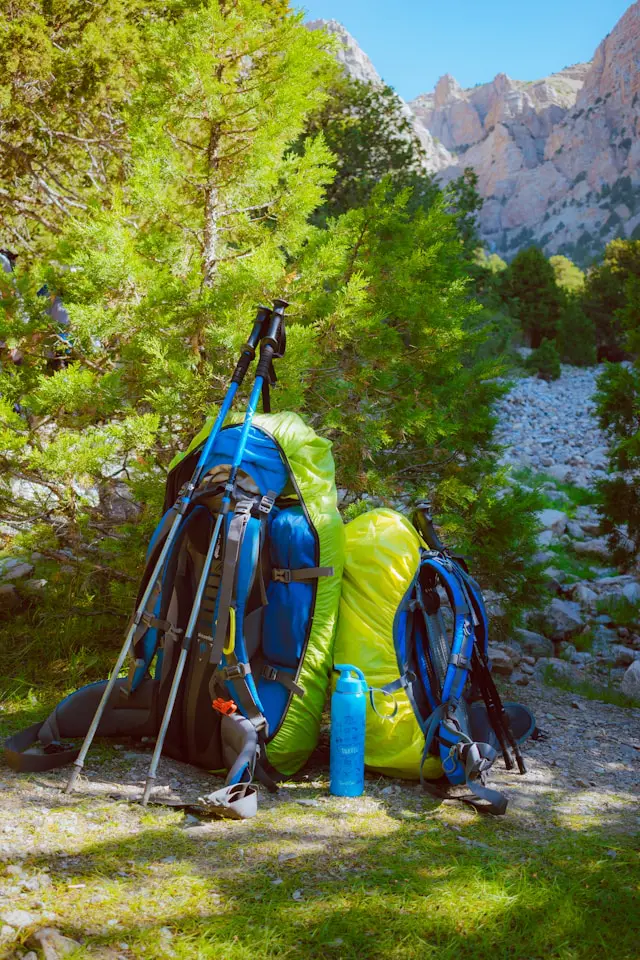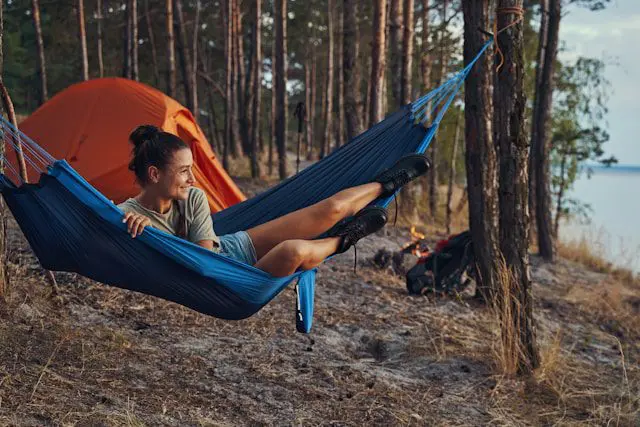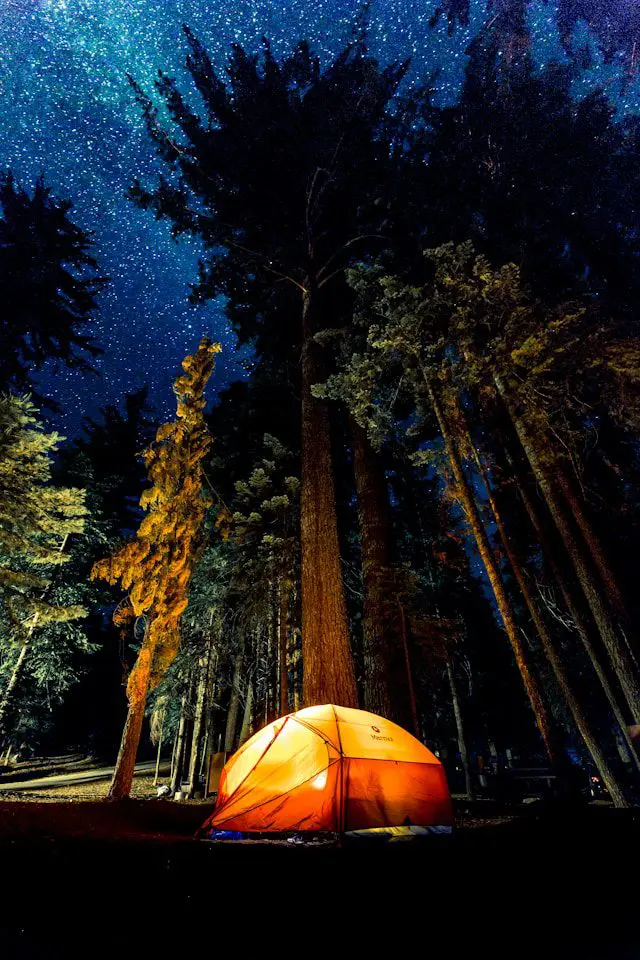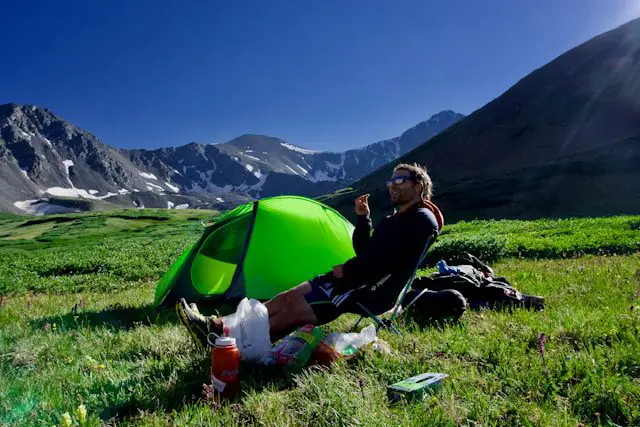Want to go camping but not sure what to bring? Whether you’re new to camping or an experienced outdoors person, this complete camping packing list will make sure you have everything you need for your next trip. We’ve carefully put together this guide to include everything from basic gear to small items you might not think of but can really improve your time outdoors.

Before You Go | Camping Packing List | Staying Safe | Protect Nature | Final Tips
Before You Start Packing
Think carefully about these important details:
Your Destination
- What’s the terrain like? (Mountains, forests, desert)
- What are the rules and regulations?
- Do you need special permits?
- Are there bears or other wildlife you need to prepare for?
Trip Length
- How many days will you stay?
- Do you need to pack extra supplies?
- How often can you resupply food and water?
Weather Conditions
- What’s the expected temperature during day and night?
- Is there a chance of rain or snow?
- How windy will it be?
- What’s the humidity like?
Planned Activities
- Will you go hiking?
- Do you want to fish or swim?
- Will you cook complex meals or keep it simple?
Transportation Method
- Are you driving to your campsite? (You can bring more stuff)
- Will you hike to your site? (You’ll need lighter gear)
- Do you need to fit everything in a backpack?

Complete Camping Packing List
Now that we’ve looked at what affects your camping needs, let’s get into the essential gear:
Shelter and Sleep Stuff
Tent
Aside from water, your tent is your most crucial piece of gear. It will protect you from the elements and wildlife.
- Size: Add 1-2 person spaces for your gear (a 2-person tent works great for one person plus gear)
- Season rating: Most people need a 3-season tent, which works for spring, summer, and fall
- Water resistance: Make sure it can handle rain and morning dew
- Durability: Check the fabric strength, stitching, and pole materials
Also bring a basic tarp for ground cover.
Our Recommendation: MSR Hubba Hubba
Why:
- It weighs only 3.9 pounds
- Easy to set up and take down
- Ripstop nylon
- DuraShield special coating keeps rain out
- Built-in rain gutter
- It handles wind and light snow well
- Cross-ventilating rainfly manages condensation while keeping the interior dry
Sleeping Bag
Temperature rating: Choose a bag rated 10°F colder than the lowest temperature you expect
Insulation type:
- Down insulation works great in dry weather and packs smaller
- Synthetic insulation keeps you warm when wet
Shape options:
- Mummy bags trap heat better but might feel snug
- Rectangular bags give you more room to move

Recommendation: The North Face One Bag
Why:
- Modular two-layer design
- You can adjust it for temperatures from 5°F to 40°F
- It has both down and synthetic layers
- It saves you money over buying multiple bags
Sleeping Pad
A good sleeping pad does two important jobs:
- It keeps you warm by creating a barrier between you and the cold ground
- It makes sleeping more comfortable by cushioning your body
When picking a sleeping pad, look at:
R-value (insulation rating):
- Summer camping: R-value of 1-3
- Spring/Fall camping: R-value of 3-5
- Winter camping: R-value of 5 or higher
Type:
- Air pads: Comfy and pack small
- Self-inflating pads: Balance comfort and durability
- Foam pads: Last longest but are bulkier
Recommendation: Therm-a-Rest NeoAir XLite
Why:
- High R-value (4.2)
- Weighs only 13 ounces
- Packs down to the size of a water bottle
- Comfortable for side sleepers
- Tough enough for regular use
Cooking and Water
Campsite Grills
Many campgrounds have grills or fire pits you can cook on. Remember:
- Bring charcoal, wood, and fire starter
- Pack a grill brush to clean the grates
- Bring aluminum foil for cooking packets

Portable Grills
Recommendation: Blackstone 1666
Why:
- Designed with portability in mind
- The griddle-like surface works great for pancakes and eggs
- Grease management system
- The surface heats evenly
Camping Stoves
Camping stoves are small, portable heat sources that are great for those in a backcountry situation where a grill isn’t feasible.
Recommendation: BioLite CampStove 2+
Why:
- It burns sticks and pinecones instead of gas
- It can charge your phone using fire heat
- It makes very little smoke
- It comes with a light
Kitchen Must-Haves
Don’t forget these important items:
- Dish soap
- Strong trash bags
- Zip-lock bags for storing food
- Can opener
- Cooler
- Coffee maker
- Knives and cutting board
- Utensils, napkins, paper towels
- Mugs, plates, and bowls
- Pots and pans
- Bottle opener
Recommendation: Sea to Summit Frontier Cook Set
Why:
- Material Quality: Hard-anodized aluminum spreads heat evenly when cooking, bowls and cups made from food-grade nylon and silicone rubber
- Collapsible and folds up small
- Click-safe lid locking
- For backcountry campers and hikers needing to fit their gear into their pack. Less valuable for those traveling by car
Water Filtration and Storage
Clean water is a super important item for any camping packing list. Bring:
- Water and extra water containers
- A way to carry water on hikes
- Water treatment tablets as backup
Recommendation: LifeStraw Go Water Filter Bottle
Why:
- It removes harmful bacteria and parasites
- You can drink directly from lakes and streams
- It makes water taste better
- It’s easy to carry
- You don’t need to wait for the water to be clean
Lights and Navigation
Headlamps, Flashlights, and Lanterns
Essential for nighttime navigation and tasks. Consider:
- Lumens (brightness)
- Battery life
- Water resistance
- Extra batteries

Recommendation: Fenix HM50R V2.0
Why:
- Very bright
- Rechargeable battery lasts 42 hours
- Rain resistant
- It has both white and red light
Finding Your Way
Always bring these backup navigation tools if you are going into unfamiliar territory or are in deep backcountry areas:
- Paper map of the area and basic compass.
- The Bureau of Land Management offers a basic map reading course for free online.
Recommendation: Garmin eTrex 10 GPS
Why:
- Navigate without cell service
- Water-resistant
- 25-hour battery life
- Mark important locations
- Track how far you’ve walked
Tools and Repair
Repair Supplies
Bring these items to fix common problems:
- Tent repair patches
- Seam sealer for tent leaks
- Strong duct tape
- Paracord: Great for hanging things like wet clothes and tarps
- Extra tent stakes
Recommendation: Leatherman Wave Plus
Why:
Leathermans are indispensable for unexpected repair needs. I used to carry one all the time in the military. The Wave Plus model is backed by a 25-year warranty and features 18 tools, including:
- Screwdrivers
- Pliers
- Wire cutters
- Sharp knife
- Saw for small branches
- Scissors
- Can and bottle openers
Medical and Safety
Medical
- Personal medications
- Pain relievers
- Antihistamines for allergies and allergic reactions
- Antiseptic wipes
- Blister treatment
Emergency Gear
- First aid kit
- Emergency blanket (the shiny kind)
- Loud whistle (to signal for help)
- Signal mirror: Attracts attention from rescue teams or aircraft
- Fire starters (waterproof matches and lighters)
Sun Protection
- Strong sunscreen (SPF 30 or higher)
- Lip balm with sun protection
- Good sunglasses
- Wide-brim hat
- Long-sleeve shirts
- Neck covering
Bug Protection
- Strong bug spray
- Head net or sleeping net for mosquitoes
- Long clothes
- Tweezers or a tick removal kit

Clothing and Footwear
Layer Your Clothes
Basic strategy:
- Base layer: Wicks sweat (avoid cotton)
- Middle layer: Keeps you warm (fleece or wool)
- Outer layer: Protects from rain and wind
Important Clothing Items
- Quick-dry underwear
- Warm socks (bring extras)
- Rain jacket and pants
- Warm hat and gloves
- Sun hat
- Swimsuit if needed
Footwear
- Strong hiking boots or shoes
- Camp shoes (like sandals)
- Water shoes if needed
- Extra laces
Personal Items and Hygiene
For the most part, bring what you would normally bring on a trip. Here are some pointers:
- Soap and water: Remember you will need extra water for hygiene, not just drinking water
- Trowel: If camping backcountry away from plumbing, remember to bring a trowel for digging a cat hole
- Toilet paper: Make sure it is in a waterproof bag
- Wet wipes: Bring a lot
Campsite Comfort
- Hammock
- Extra pillows
- Camp rug or mat
- Battery-powered fan
- Camp slippers
Recommendation: Helinox Chair One
Why:
- It weighs less than a bottle of wine
- Holds up to 320 lbs.
- Measures 4 x 4.5 x 14 inches when packed
- It dries quickly
- It’s comfortable
Staying Safe
- Tell someone where you’re going
- Check weather reports often
- Stay on or near marked trails and designated areas
- Keep your campsite clean to avoid hungry wildlife like bears
- Learn what to do if you do encounter wildlife
- Store food in sealed containers away from animals
- Know what to do if you get lost
- Learn basic first aid
- Pack extra batteries and portable chargers

Final Advice: Your Camping Adventure Awaits
Remember, every camping trip teaches you something new. Start with the basics and add gear as you learn what works for you. Also remember to have fun and take pictures. Happy camping!
Share your thoughts in the comments below—what’s your must-have item in your camping packing list?
Related Resources
- Explore our guide to find the best rooftop tents that turn your vehicle into an instant campsite. Top picks inside.
- Explore 25 essential electric bike accessories to improve your ride, blending top safety, comfort, and performance features.
- Discover the 10 best meditation books for beginners to guide you down the path of mindfulness. These books offer helpful tips and insights for beginners.


Leave a Reply